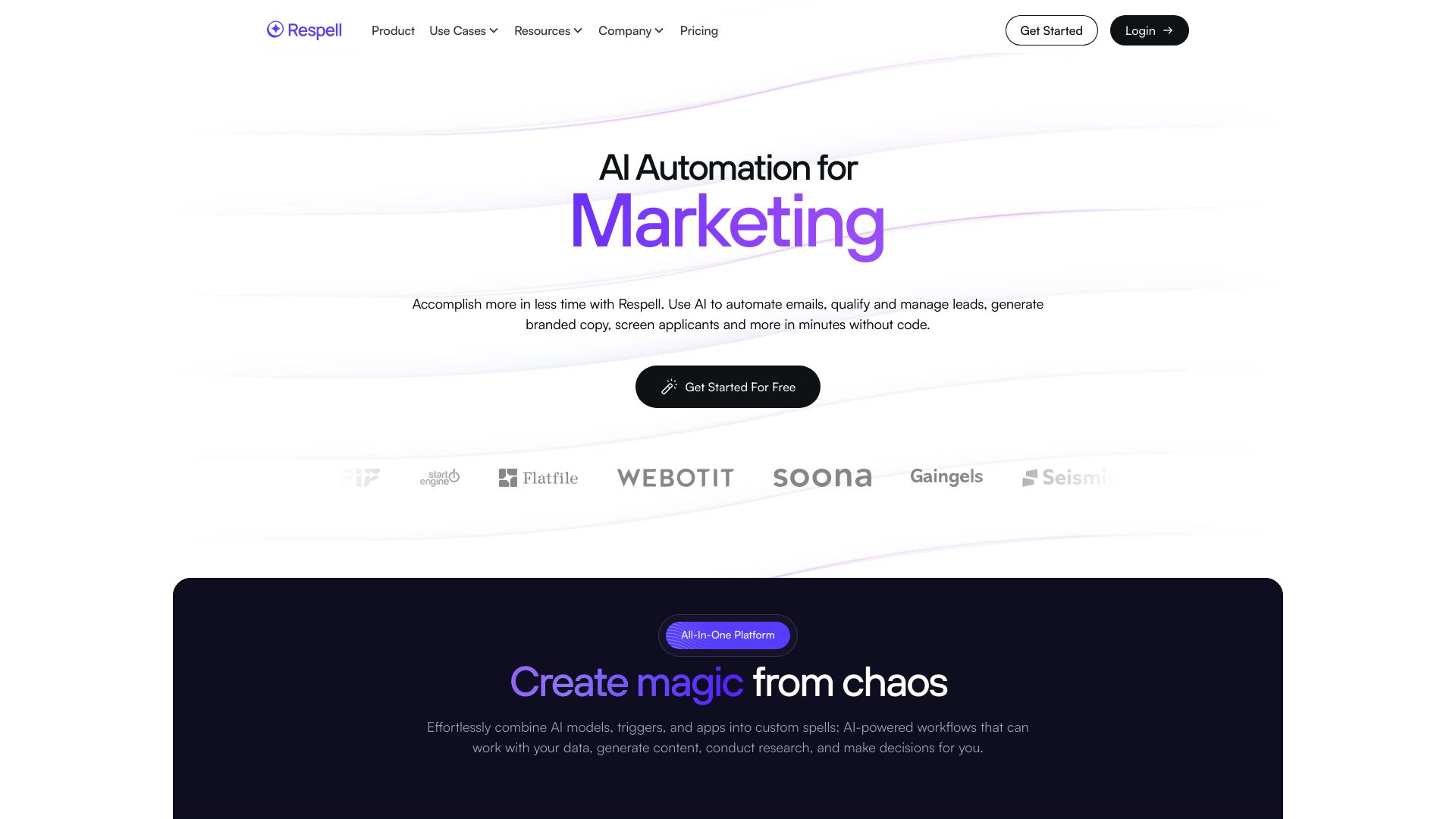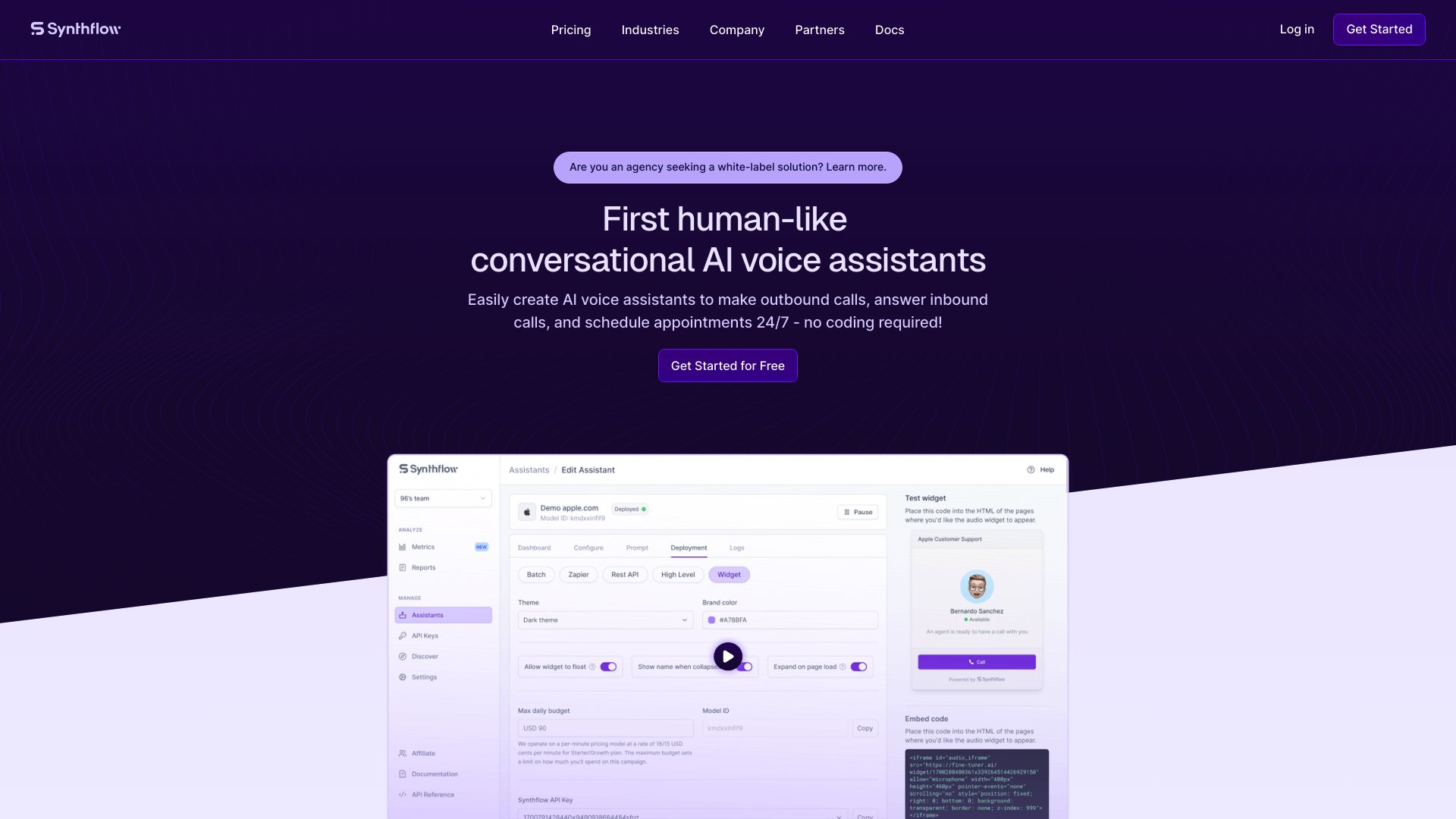Respell vs. Synthflow: AI Workflow Tools Compared
The AI agent creation landscape brims with innovative solutions, each vying to simplify complex workflows and empower businesses. This review dissects two prominent platforms, Respell vs. Synthflow, examining their unique approaches to AI-driven automation. Respell’s versatile no-code environment enables the construction of sophisticated AI workflows, while Synthflow specializes in voice-based AI assistants.
We’ll explore their core features, integration capabilities, and security measures, providing a comprehensive comparison to help you navigate the AI tooling ecosystem. Whether you’re a developer seeking advanced customization or a business leader aiming to streamline operations, this analysis will equip you with the insights needed to make an informed decision in your AI journey.
Respell Overview
Respell revolutionizes AI workflow creation with its no-code platform, empowering users to build sophisticated AI agents and automations effortlessly. The platform’s core offering, Spell Studio, provides a visual drag-and-drop interface where users construct AI-driven workflows called ’spells’ without writing code.
Respell revolutionizes AI workflow creation with its no-code platform, empowering users to build sophisticated AI agents and automations effortlessly.


Respell caters to a diverse audience, from developers seeking advanced API integrations to non-technical professionals looking for ready-made templates. Its AI assistant, Elle, learns team processes and suggests optimizations, streamlining workflows across various industries. The platform excels in its integration capabilities, connecting seamlessly with popular services like Airtable, Salesforce, and Zapier, extending its reach to over 6,000 external applications.
Respell caters to a diverse audience… Its AI assistant, Elle, learns team processes and suggests optimizations, streamlining workflows across various industries.
Key features of Respell include its multimodal support for text, image, and speech models, enabling versatile AI applications. The platform offers robust debugging tools, allowing users to preview and test their spells before deployment. Respell also provides comprehensive analytics and monitoring capabilities, giving users insights into their AI workflows’ performance.
While Respell offers significant advantages in AI workflow creation, it lacks certain features found in more specialized platforms. The absence of a hosted vector database and specific crawlers for sitemaps or YouTube transcripts might limit its applicability in certain data-intensive scenarios. Additionally, the platform does not explicitly mention features like IP control or staging domains, which could be important for enterprise-level security and development processes.
Synthflow Overview
Synthflow empowers businesses to create AI voice assistants without coding expertise. The platform’s no-code interface and pre-built templates streamline the development of customizable AI agents for diverse applications like customer support, lead generation, and appointment scheduling.


Synthflow excels in user-friendliness and versatility. Its visual builder enables users to design AI workflows through drag-and-drop functionality. The platform supports both development and production environments, facilitating seamless testing and deployment of AI agents. Synthflow’s commitment to data security shines through its unlimited secure storage in a dedicated Pinecone environment, addressing privacy concerns for businesses handling sensitive information.
Synthflow empowers businesses to create AI voice assistants without coding expertise. The platform’s no-code interface and pre-built templates streamline the development of customizable AI agents…
The platform’s integration capabilities extend its functionality. Synthflow connects with tools like 11Labs for voice synthesis and Twilio for communication, enhancing the AI assistants’ capabilities. Users can deploy their creations through multiple channels, including GoHighLevel, Zapier, REST API, and website widgets, providing flexibility in how businesses engage with their audience.
While Synthflow offers a robust set of features, it lacks some advanced capabilities found in other platforms. The absence of a hosted vector database and specialized crawlers for web content or YouTube transcripts may limit its utility for certain data-intensive applications. Additionally, there’s no mention of staging domains or production domains for more granular control over deployment environments.
Despite these limitations, Synthflow’s focus on accessibility and practical business applications makes it a compelling choice for organizations looking to leverage AI without extensive technical resources. Its vision of democratizing AI technology aligns with the growing demand for user-friendly tools that can drive business growth and enhance customer engagement across various industries.
Feature Comparison
Respell and Synthflow offer distinct approaches to AI agent creation, each with its own strengths and limitations. Respell excels in providing a comprehensive no-code platform for building AI workflows, while Synthflow focuses on creating voice-based AI assistants.
In terms of core components, Respell’s Spell Studio offers a more versatile visual builder, enabling users to create complex AI workflows for various applications beyond voice interactions. Synthflow, while proficient in voice assistant creation, lacks the breadth of Respell’s drag-and-drop interface for general AI workflow design.
Security features highlight significant differences between the platforms. Respell implements robust data encryption and OAuth authentication, enhancing data protection and access control. Synthflow, while offering secure storage in a dedicated Pinecone environment, does not explicitly mention features like IP control or OAuth, potentially limiting its appeal for enterprises with stringent security requirements.
Feature Comparison Table
| Respell | Synthflow | SmythOS | |
|---|---|---|---|
| CORE FEATURES | |||
| Multimodal | ✅ | ❌ | ✅ |
| SECURITY | |||
| Constrained Alignment | ❌ | ✅ | ✅ |
| IP Control | ❌ | ❌ | ✅ |
| COMPONENTS | |||
| Huggingface AIs | ❌ | ❌ | ✅ |
| Classifiers | ✅ | ❌ | ✅ |
| Data Lakes | ❌ | ❌ | ✅ |
| DEPLOYMENT OPTIONS (EMBODIMENTS) | |||
| Staging Domains | ❌ | ❌ | ✅ |
| Production Domains | ❌ | ❌ | ✅ |
| Deploy as GPT | ❌ | ✅ | ✅ |
| DATA LAKE SUPPORT | |||
| Hosted Vector Database | ❌ | ✅ | ✅ |
| Sitemap Crawler | ❌ | ✅ | ✅ |
| YouTube Transcript Crawler | ❌ | ✅ | ✅ |
| URL Crawler | ✅ | ❌ | ✅ |
| PDF Support | ✅ | ❌ | ✅ |
| Word File Support | ✅ | ❌ | ✅ |
| TXT File Support | ✅ | ❌ | ✅ |
Best Alternative to Respell and Synthflow
SmythOS stands out as the superior alternative to Respell and Synthflow for AI agent creation and deployment. Our platform combines an intuitive visual interface with powerful capabilities, making advanced AI accessible to users of all skill levels. We offer a comprehensive solution that addresses the limitations of both Respell and Synthflow.
SmythOS stands out as the superior alternative to Respell and Synthflow for AI agent creation and deployment. Our platform combines an intuitive visual interface with powerful capabilities…
Unlike Respell’s focus on AI workflows and Synthflow’s emphasis on voice assistants, SmythOS provides a versatile environment for creating multimodal AI agents. Our drag-and-drop interface surpasses Respell’s Spell Studio, enabling users to design complex AI systems for a wide range of applications beyond voice interactions.
Security is a top priority for SmythOS. We implement robust data encryption, OAuth authentication, and IP control features, surpassing the security offerings of both Respell and Synthflow. This makes our platform ideal for enterprises with stringent data protection requirements.
SmythOS excels in its extensive integration capabilities. We support a vast array of AI models, including those from Hugging Face, and offer seamless integration with various APIs and data sources. This flexibility allows users to create sophisticated AI solutions tailored to their specific needs.
Our platform’s scalability and deployment options set it apart. SmythOS supports staging and production domains, enabling smooth development and deployment processes. Users can deploy their AI agents as APIs, webhooks, chatbots, or even GPTs, providing unmatched versatility in how AI solutions are implemented and utilized.
Conclusion
Respell and Synthflow offer unique approaches to AI agent creation, each with distinct strengths. Respell’s versatile Spell Studio empowers users to craft complex AI workflows across various applications. Synthflow specializes in voice-based AI assistants, providing a focused solution for businesses seeking to enhance customer interactions.
While both platforms offer no-code interfaces and integration capabilities, SmythOS emerges as the superior choice for businesses and developers seeking a comprehensive AI solution. Our platform combines the best of both worlds — the versatility of Respell and the specialized focus of Synthflow — while offering additional features that set it apart.
SmythOS excels with its extensive integration ecosystem, supporting over 300,000 integrations and a wide range of AI models. Our drag-and-drop interface simplifies complex AI workflow creation, making it accessible to both technical and non-technical users. Unlike Respell and Synthflow, SmythOS provides advanced features such as multi-agent orchestration, versatile deployment options, and a hosted vector database, enabling more sophisticated and scalable AI solutions.
For businesses looking to harness the full potential of AI, SmythOS offers unparalleled flexibility and power. Our platform empowers users to create once and deploy anywhere, from chatbots to APIs, ensuring seamless integration with existing systems. Explore our diverse range of AI-powered agent templates to jumpstart your AI journey, or dive into our comprehensive documentation to unlock the full capabilities of SmythOS. Ready to revolutionize your approach to AI? Get started with SmythOS today and experience the future of AI automation.
Last updated:
Disclaimer: The information presented in this article is for general informational purposes only and is provided as is. While we strive to keep the content up-to-date and accurate, we make no representations or warranties of any kind, express or implied, about the completeness, accuracy, reliability, suitability, or availability of the information contained in this article.
Any reliance you place on such information is strictly at your own risk. We reserve the right to make additions, deletions, or modifications to the contents of this article at any time without prior notice.
In no event will we be liable for any loss or damage including without limitation, indirect or consequential loss or damage, or any loss or damage whatsoever arising from loss of data, profits, or any other loss not specified herein arising out of, or in connection with, the use of this article.
Despite our best efforts, this article may contain oversights, errors, or omissions. If you notice any inaccuracies or have concerns about the content, please report them through our content feedback form. Your input helps us maintain the quality and reliability of our information.
